Exhibition Label Insights
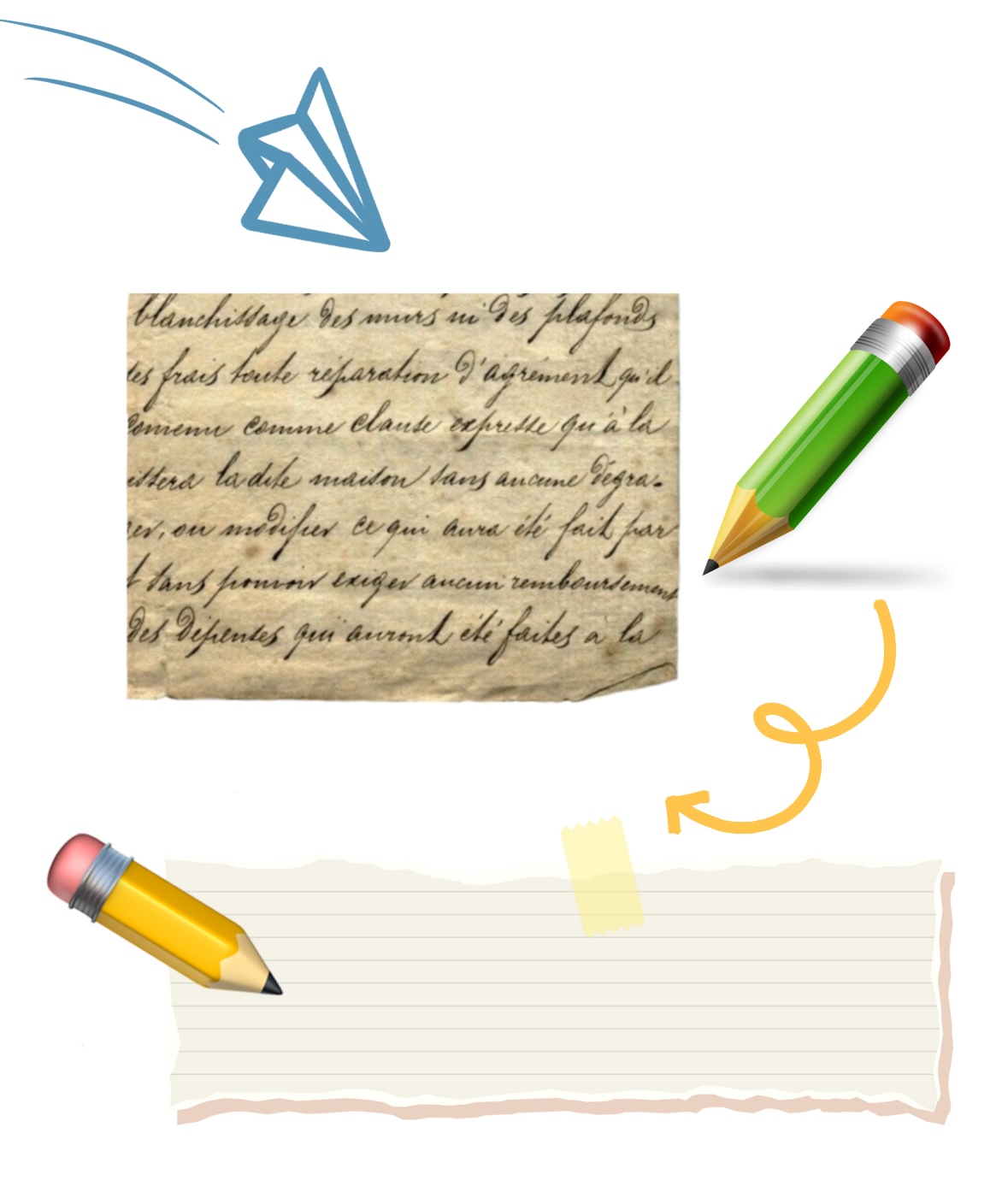
Summary
This toolkit provides a step-by-step guide to creating effective exhibition labels. It covers the basics of research, concise writing, and organizing information in four levels: immediate object details, interpretative insights, contextual background, and abstract information. Learners will analyze examples, write their own labels, and compare their work to professional standards, building skills to make art accessible and engaging for diverse audiences.
Have you ever noticed the small labels beside artworks in a museum?
Do you know what goes into crafting these brief but insightful descriptions?
Do you know that each one is carefully crafted to tell a story?
Exhibition labels are more than just names and dates—they provide context, meaning, and connection to each piece of art.
If you’re curious about what goes into crafting these labels, keep reading! You’ll discover how to capture an artwork’s essence and engage viewers through the art of label writing. Ready to dive in?
Let’s explore the techniques and secrets that make exhibition labels an essential part of any museum visit.
Unit 1: Introduction to Basic Rules of Exhibition Label Writing (5 minutes)
Writing exhibition labels requires a thorough understanding of the artwork, artist, context, and themes. Research skills are crucial for gathering accurate information that adds depth to the label content. Exhibition labels are brief, so each word must count. Writing concisely without losing depth is a skill that improves with practice. This unit introduces key strategies for effective label writing, divided into several steps:
- Immediate Object Information: This level gathers information that is most intellectually close to the object. It includes basic naming and description, coveringthe title of the object, descriptive terms that characterize the object, details about the materials used in the objectand a general overview of the object’s appearance and attributes.
- Interpretative Information: This level gathers information that is closely related to the object, derived from its meaning. These details help validate and explain the initial naming and description, coveringthe symbolic or conceptual significance of the object, the methods and processes used to create the object and the intended function or role of the object.
- Contextual Information: This level gathers moderate contextual information, which is an abstraction relevant to the object but broader in scope. It includesinformation related to the artist or individuals associated with the object and the classification or genre the object belongs to, connecting it to broader categories.
- Abstract Information: This level gathers abstracted information that is more removed from the object itself. These statements relate to, but do not directly derive from, the object’s visual characteristics and includehistorical Context, geographical Context and additional contextual references that enrich understanding, drawing connections that may go beyond the immediate visual or physical aspects of the object.
Unit 2: Case Study Analysis (5 minutes)
To deepen your understanding of exhibition label writing, let’s explore a real-life example from the Museum of Modern Art (MoMA). Have you ever wondered what makes a label truly memorable? How do a few carefully chosen words add layers of meaning to an artwork?
Let’s take a closer look at MoMA’s label for Christo’s Package on Wheelbarrow (1963). Through this case study, you’ll see how MoMA structures its labels to provide viewers with a comprehensive yet concise understanding of the artwork.
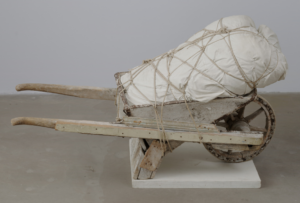
MoMA’s Exhibition Label for “Package on Wheelbarrow”:
In his early twenties, Christo escaped the oppressive Communist regime in his native country and wandered in exile throughout Europe, supporting himself primarily by painting commissioned portraits. He has related his early wrapped-package works to the isolation and sadness of his coming of age in Bulgaria; the wheelbarrow, in particular, suggests a stateless, nomadic life. In 1964, shortly after making Package on Wheelbarrow, Christo relocated to New York City. There, in partnership with his wife, Jeanne-Claude, he has created large-scale temporary installations, wrapping trees, islands, buildings, and bridges in fabric.
https://www.moma.org/collection/works/81908
Take a moment to imagine how this label might shape your experience if you encountered this artwork in the museum. Would knowing these details change your understanding of the piece? Let’s break down MoMA’s approach to see why each part of the label matters.
Analysis of the Label:
- Immediate Object Information:
- Title: Package on Wheelbarrow
- Artist: Christo
- Date: 1963
- Medium: Cloth, metal, wood, rope, and twine
- Dimensions: 89.1 x 151 x 51.4 cm
This basic information provides essential context for viewers. Imagine if you didn’t know the medium or the artist—would you see the work differently?
- Interpretative Information:
The label discusses how Christo’s wrapped objects express a sense of isolation and sadness, linking these emotions to his experience growing up in Bulgaria under a restrictive regime.
The description of the wheelbarrow as “stateless” introduces its symbolic purpose, portraying it as a metaphor for Christo’s own nomadic and uncertain existence during exile.
Think about it: could you tell this story just by looking at the artwork? This interpretative layer helps you connect to the artist’s experience and understand the symbolism within the piece, enriching your viewing experience.
- Contextual Information:
Personal context is provided by detailing Christo’s life journey, including his exile from Bulgaria and the struggle to find a new life across Europe.
The label also connects this piece to the genre of Christo’s wrapped works, which would later evolve into large-scale environmental projects.
This layer situates the object within Christo’s personal history and the broader art movement of the 1960s, giving viewers a sense of its place in the artist’s oeuvre and its link to other works in the same genre.
- Abstract Information:
The historical context touches on the oppressive political climate of Eastern Europe that led to Christo’s exile, framing the work against the backdrop of Cold War tensions.
Geographically, the label mentions his journey across Europe and eventual relocation to New York, showing how his physical displacement influenced his art.
These broader elements help visitors understand the political and social forces that shaped Christo’s work. Does knowing about these historical events deepen your appreciation for the piece?
Unit 3: Practice Writing an Exhibition Label (7 minutes)
To put your exhibition label writing skills into practice, let’s explore some notable contemporary artworks from the Museum of Modern Art (MoMA). Select one of the following pieces and apply the four levels of information introduced in Unit 1 to create a 50-100 word label. This exercise will help you write a concise, impactful label that communicates the essence of the artwork.
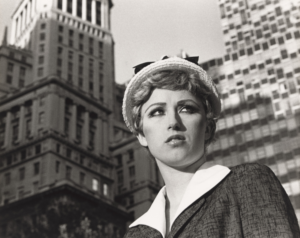
“Untitled Film Still #21” (1978) by Cindy Sherman
- Medium: Gelatin silver print
- Dimensions: 20.3 x 25.4 cm
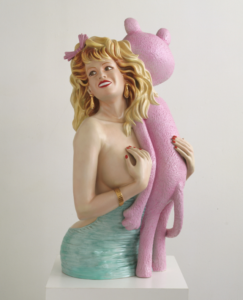
- Medium: Porcelain
- Dimensions:104.1 x 52 x 48.2 cm
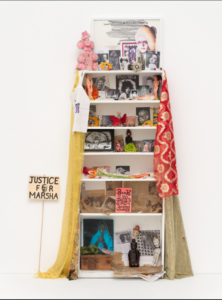
- Medium:Mixed-media installation, with jewelry, pins, and textiles; plastic, metal, glass, and papier-
mâché objects; photographs, postcards, paper mask, protest sign, memorial-service cardsand programs, and newspaper and magazine clippings; and original artworks by ScottCovert, Ken Angel Davis with CAConrad, and Gene Fedorko with Stephen Tashjian (Tabboo!) - Dimensions:232.4 × 91.4 × 25.4 cm
Unit 4: Reflection and Comparison (3 minutes)
Now that you’ve written an exhibition label, it’s time to reflect on the process and identify areas for improvement.
How well does your label capture the essence of the artwork? Have you conveyed the necessary context, meaning, and broader implications concisely? Let’s dive into a comparison exercise to refine your skills.
Here are the links below:
https://www.moma.org/collection/works/56618(“Untitled Film Still #21” (1978) by Cindy Sherman)
https://www.moma.org/collection/works/81095(“Pink Panther” (1988) by Jeff Koons)
https://www.moma.org/collection/works/433228(“Shrine(White)”(2022)by Agosto Machado)
Exhibition Label Insights © 2024 by Zhouyuan WU is licensed under CC BY-SA 4.0
(cover image © 2024 by Zhouyuan Wu is licensed under CC BY-SA 4.0 )
(“Package on Wheelbarrow” © 1963 by Christo, MOMA is licensed under CC BY-SA 4.0 )
(“Untitled Film Still #21”© 1978 by Cindy Sherman, MOMA is licensed under CC BY-SA 4.0 )
(“Pink Panther” © 1988 by Jeff Koons, MOMA is licensed under CC BY-SA 4.0 )
(“Shrine(White)”© 2022 by Agosto Machado, MOMA is licensed under CC BY-SA 4.0 )
(Exhibition Label Insights © 2024 by Zhouyuan Wu is licensed under CC BY-SA 4.0 )


